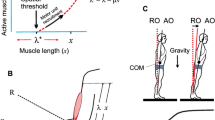Abstract
A model is introduced for the motor program which controls final position. The first part of the model relates the biomechanical properties of the muscles to the EMG activities of the extensor and flexor muscles and thereby generates quatitative predictions for the relationships between the EMGs, final position, external forces, muscle stiffness, and muscle tension. To the extent that comparable data exist, the model is shown to give correct quantitative predictions. When only qualitative comparisons can be made, the model is consistent with the data in the literature. The model is complete and can be tested quantitatively in detail in the future. An equivalent circuit for the neural network that innervates the muscles is given. It is shown to have the advantages of making the programming of final position simple to either compute or lookup in a table. In addition, new situations, such as adapting to a force, or an unusual viewing angle, lead to very simple changes in the basic program in terms of the equivalent circuit.
Similar content being viewed by others
References
Asatryan, D.G., Fel'dman, A.G.: Biophysics of complex systems and mathematical models. Functional tuning of nervous system w/control of movement or maintenance of a steady posture. 1. Biophys. 10, 925–935 (1965)
Basmajian, J.V.: Muscles alive. Baltimore: Williams & Wilkins 1962
Bizzi, E., Polit, A.: Characteristics of the motor programs underlying visually evoked movements. In: Posture and movement. Talbot, R.E., Humphrey, E. (eds.) New York: Raven Press (in press) (1980)
Bizzi, E., Polit, A., Morasso, P.: Mechanisms underlying achievement of final head position. J. Neurophysiol. 39, 435–444 (1976)
Bossom, J.: Movement without proprioception. Brain Res. 71, 285–296 (1974)
Bouisset, S., Lestienne, F., Maton, B.: The stability of synergy in agonist during the execution of a simple voluntary movement. Electroencephalogr. Clin. Neurophysiol. 42, 543–551 (1977)
Brooks, V.B.: Introductory lecture to session. III. Some examples of programmed limb movements. Brain Res. 71, 299–308 (1974)
Buck, L.: The sensory basis of target location. Q. J. Exp. Psych. 31, 111–120 (1979)
Cnockaert, J.C., Pertuzon E.: Sur la géometrie musculo-squelettique du triceps bracchi. Application à la détermination dynamique de sa compliance. Eur. J. Appl. Physiol. 32, 149–158 (1974)
Evarts, E.V., Vaughn, W.J.: Intended arm movements in response to externally produced arm displacements in man. In: Cerebral motor control in man: long loop mechanisms. Desmedt, J.E. (ed.) (Prog. Clin. Neurophysiol.) Basel: Karger 1978
Fel'man, A.G.: Functional tuning of nervous system w/control of movement or maintenance of steady posture. II. Controllable parameters of the muscles. Biophysics 11, 565–578 (1966a)
Fel'man, A.G.: Functional tuning of nervous system during control of movement or maintenance of a steady posture. III. Mechanographic analysis of the execution by man of the simplest motor tasks. Biophysics 11, 766–775 (1966b)
Houk, J., Henneman, E.: Freedback control of muscle: introductory concepts. In: Medical physiology. Mountcastle, V.B. (ed.). St. Louis: Mosby Comp. 1974
Keele, S.W.: Movement control in skilled motor performance. Psychol. Bull. 70, 387–403 (1968)
Keele, S.W.: Behavior analysis of motor control. In: Draft for handbook, 1980
Kelso, J.A.S.: Motor control mechanisms underlying human movement reproduction. J. Exp. Psychol. 3, 529–543 (1977)
Kozlovskaya, I.B., Atkin, A., Horvath, F.E., Thomas, J.S., Brooks, V.B.: Preprogrammed and feedback-guided movements of monkeys. Behav. Biol. 12, 243–248 (1974)
Lashley, K.S.: The accuracy of movement in the absence of excitation from the moving organ. Am. J. Physiol. 43, 169–194 (1917)
Lestienne, F.: Programme moteur et mécanismes de l'arrêt d'un mouvement monoarticulaire. Thèse de Doctorat d'Etat, Lille, 1974
Lestienne, F., Polit, A., Bizzi, E.: Transition from movement to posture: an electromyographic study. Paper presented at the meeting for the Society of Neuroscience, St. Louis, MO, 1978
MacNeilage, P.F.: Motor control of serial ordering of speech. Psychol. Rev. 77, 182–196 (1970)
Marteniuk, R.G., Roy, E.A.: The codability of kinesthetic location and distance information. Acta Psychol. 36, 471–479 (1972)
Merton, P.A.: The properties of the human muscle servol. Brain Res. 71, 475–478 (1974)
Nichols, T.R., Houk, J.C.: Improvement in linearity and regulation of stiffness that results from actions of stretch reflex. J. Neurophysiol. 39, 119–142 (1976)
Polit, A., Bizzi, E.: Processes controlling arm movements in monkeys. Science 210, 1235–1237 (1978)
Polit, A., Bizzi, E.: Characteristics of motor programs underlying arm movement in monkeys. J. Neurophysiol. 42, 183–194 (1979)
Russell, D.G.: Spatial location cues and movement reproduction. In: Motor control. Stelmach, G.E. (ed.) New York: Academic Press 1976
Sakitt, B, Lestienne, F., Zeffiro, T.: Control of forearm position. To be presented at the meeting for the Society of Neuroscience, Cincinnati, Ohio 1980
Taub, E., Goldberg, I.A., Taub, P.: Deafferentation in monkeys: pointing at a target without visual feedback. Exp. Neurol. 46, 178–186 (1975)
Vredenbregt, J., Rau, G.: Surface electromyography in relation to force, muscle, and endurance. In: New developments in electromyography and clinical neurophysiology. Desmedt, J.E. (ed.) Basel: Karger 1973
Author information
Authors and Affiliations
Rights and permissions
About this article
Cite this article
Sakitt, B. A spring model and equivalent neural network for arm posture control. Biol. Cybernetics 37, 227–234 (1980). https://doi.org/10.1007/BF00337041
Received:
Issue Date:
DOI: https://doi.org/10.1007/BF00337041




